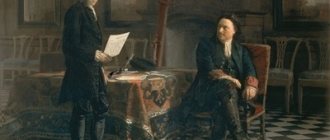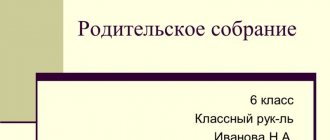Lesson topic: “The era of palace coups. 1725 - 1762." - presentation
Lesson topic: “The era of palace coups.”
The era of palace coups in the history of Russia is considered to be the period when the rulers on the throne changed 5 times with the help of weapons. The main reason for the frequency and ease of coups was the strengthening of the role of the guard, noble in composition, in state affairs.
1718 - Peter I's son Alexei died under mysterious circumstances. Alexei
1722 - the Charter on the succession to the throne was adopted, according to which the appointment of an heir was “in the will of the ruling sovereign.”
1724 - Catherine I (Martha Skavronskaya) is crowned by Peter I as the reigning queen. Catherine I
1725 Peter I died. Peter I on his deathbed
1725 – 1727 - period of reign of Catherine I. Catherine I
1726 - creates the Supreme Privy Council, in which it unites representatives of the old family nobility (Dolgoruky, Golitsyn, Repnin) and Peter’s promoters (Menshikov, Golovkin, Tolstoy). A. Menshikov G. Golovkin
Shortly before her death, Catherine I signed a decree transferring the throne to Peter II (grandson of Peter the Great); until he came of age, his guardian was to be the Supreme Privy Council headed by A.D. Menshikov. Peter II
In addition, the dying queen gave her consent to the marriage of Peter II with Maria Menshikova (daughter of A.D. Menshikov) M. Menshikova
1727 – 1730 - the period of the reign of Peter II.
Soon after the accession of Peter II A.D. Menshikov and his entire family were sent into exile to the Siberian town of Berezov, where he soon died. Ekaterina Dolgorukaya became the royal bride. E. Dolgorukaya
The Supreme Privy Council became clearly aristocratic - of its eight members (supreme leaders), six belonged to the old nobility
Peter II returned his grandmother Evdokia Lopukhina from exile. E. Lopukhina
Peter II died on his wedding day. Funeral of Peter II
1730 – 1740 - the period of Anna Ioannovna's reign.
After the death of Peter II, the choice of a new head of state depended entirely on the decision of the “Supreme”. They chose the niece of Peter I, Anna Ioannovna, the widow of the poor Duke of Courland.
But Anna Ioannovna had to sign the conditions - the conditions of the invitation to the Russian throne. Thus, for the first time an attempt was made to limit the absolute power of the Russian monarch.
The head of the Theological College Feofan Prokopovich, the guard, and the nobility actively opposed the standards, because they sincerely considered the autocratic government to be a reliable defender of their interests. Feofan Prokopovich
“It is better to be the slave of one despot than of many.” F. Prokopovich
Anna Ioannovna publicly tore up the sheet of conditions she had already signed, the Supreme Privy Council was dissolved, its members were expelled from the capital, some were executed. Anna Ioannovna breaks her condition
Together with Anna Ioannovna, many Baltic Germans arrived from Courland and took key positions in government bodies:
E. Biron - First Minister E. I. Biron
A. Osterman - Vice-Chancellor A. I. Osterman
B. Minikh - head of the military board of B.K. Minich
1730 - The Supreme Privy Council was abolished, the Cabinet of Ministers was created, consisting of only 3 people appointed by the Empress
1731 - the Office of Secret Investigation Cases was created, which was in charge of cases of state crimes.
In 1731, the Izmailovsky Guards Regiment was created, which was devoted only to Anna Ioannovna. Oath of the Izmailovsky Regiment Soldiers of the Izmailovsky Regiment
1731 - the Land Noble Corps was established, intended only for nobles, whose graduates became officers, thereby avoiding all the hardships of soldier service. Building of the Land Noble Corps
1736 - a Decree was adopted limiting the period of service to the state - 25 years; The landowner father could leave one of the sons at home to manage the household; Peter I's decree on single inheritance was canceled (now the nobles could bequeath estates at their own discretion).
Anna Ioannovna suppressed any attempts by the Russian nobility to limit the dominance of foreigners in Russia.
So in 1740 A.P. was executed. Volynsky (cabinet - minister) and his associates, who sought the transfer of positions from clerk to senator to Russian nobles.
Anna Ioannovna was fond of balls, hunting, and court festivities; she loved to surround herself with dwarfs, all kinds of freaks, who were her jesters.
Shortly before her death, Anna Ioannovna appointed the little son (2 months) of her niece Anna Leopoldovna and Anton-Ulrich (Duke of Brunswick) as her successor. Anna Leopoldovna Anton-Ulrich
Biron was appointed regent under the young sovereign John Antonovich. In this way she wanted to thank her favorite and ensure his future.
1740 – 1741 - Ivan Antonovich.
In 1740, Field Marshal Minikh, at the head of a guards detachment, arrested Biron and proclaimed his mother Anna Leopoldovna regent for the young emperor.
This was the third coup in 15 years.
However, Minich himself was soon removed from power by an influential member of the Cabinet of Ministers and a very experienced court intriguer Osterman.
1741 - the guard carried out a new coup d'etat in favor of the daughter of Peter I, Elizabeth. Anna Leopoldovna and Anton-Ulrich were arrested and sent into exile. The baby emperor was imprisoned somewhat later in the Shlisselburg fortress. Minikh and Osterman were sent into exile.
1741 – 1761 - period of the reign of Elizabeth I. Elizabeth I
“Sovereign Daughter Petra...” A.S. Pushkin
Elizabeth became for the nobles the personification of the Russian principle, because immediately proclaimed a return to the policies of her father. Lover of balls, entertainment, outfits.
Under her, as before, a prominent role was played by favorites - Razumovsky, Shuvalov, Bestuzhev-Ryumin A.G. Razumovsky I.I. Shuvalov A.P. Bestuzhev-Ryumin
Elizabeth abolished the Cabinet of Ministers and revived the Governing Senate. She also revived the activities of the collegiums. Senate meeting
In the second half of the 50s, under Elizabeth, a conference arose at the highest court, which occupied a position higher than the Senate.
After Elizabeth's death, the Conference ceased to be convened. Elizabeth abolished the death penalty. The nobility received the right to exile their serfs to Siberia for settlement without trial. The nobility was freed from humiliating punishments with rods and whips.
1754 - Decree on the abolition of internal customs duties; in return, duties were increased on goods imported and exported from Russia
1754 - The Noble Land Bank was created, which provided loans to the nobles on the most favorable terms. Building of the Noble Land Bank
1755 - Decree on the attachment of peasants to factories (factory serfs).
Back in 1742, Elizabeth appointed herself a successor - her nephew Pyotr Fedorovich (son of Anna Petrovna and the Duke of Holstein) Pyotr Fedorovich
When Pyotr Fedorovich turned 14 years old, Elizabeth called him to Russia in the hope of making him a worthy emperor, but her hopes were not justified.
Elizabeth married her nephew to Princess Sophia Augusta Frederica of Anhalt of Zerbst - the future Catherine the Great.
From this marriage a boy was born in 1754, who was named Pavel. Elizabeth began to think about transferring rights to the Throne to him. Paul I
gg. the period of the reign of Peter III. Peter III
Peter III reigned for only 186 days and was overthrown by his wife Catherine and her favorites. He was sent under arrest to the small town of Ropsha near St. Petersburg and was soon killed by A. Orlov. A.G. OrlovEkaterina II
This was the 5th palace coup since the death of Peter the Great.
1762 The “Manifesto on the Freedom of the Nobility” was adopted, according to which the nobles were exempted from compulsory service to the state; nobles received the right to resign at their own discretion.
During the period of palace coups, the formation of the nobility was completed as a special, most privileged class, which had only rights and privileges in the complete absence of responsibilities in relation to the state.
The era of palace coups (1725-1762) presentation for a history lesson (8th grade)
Slide 1
The era of palace coups (1725-1762) Chaika Natalya Vasilievna, teacher of history and social studies
Slide 2
Lesson plan Reasons and essence of palace coups. Catherine I (1725-1727) Peter II (1727-1730) “Verkhovniki” (1730) Anna Ioannovna (1730-1740) Ivan Antonovich (1740-1741) Elizaveta Petrovna (1741-1761) Peter III (1761-1762)
Slide 3
Basic concepts: palace coup, constitutional monarchy, Supreme Privy Council, temporary workers, “conditions”, heir to the throne. Main dates: 1725-1727, 1727-1730, 1730-1740, 1740-1741, 1741-1761, 1761-1762 1762
Slide 4
Problem task: For 37 years - since 1725. to 1762 There were 6 rulers on the Russian throne. All of them ascended the throne as a result of palace coups. Explain why this became possible.
Slide 5
Peter I Alekseevich (the Great) 1682-1725 1722 - decree on succession to the throne of 1725 - Peter I died before he could appoint a successor for himself. The “Testament” instructs Peter’s successors to conduct continuous military operations, through wars and diplomatic intrigues to subjugate all of Europe, divide Poland, neutralize Turkey and conquer India, thus achieving complete Eurasian hegemony. Some of Peter’s “behaviors” had already “come true” by the time the falsification appeared (for example, dynastic unions with the German states, the active involvement of the cultural experience of the West, expanding access to the Black Sea and the division of Poland), which made the remaining “plans” more convincing.
Slide 6
The “era of palace coups” in the history of Russia is the period lasting from 1725 (after the death of Peter I) to 1762 (before the beginning of the reign of Catherine II) and characterized by: the struggle of court factions by the continuous change (by force) of reigning persons on the throne. There is no single scientific definition of a palace coup, and there are no clear time boundaries for this phenomenon. Thus, V. O. Klyuchevsky (the author of the term) dates the era of palace coups from 1725 to 1762. However, today there is another point of view - 1725-1801. (The fact is that V. O. Klyuchevsky could not, in a public lecture given in the mid-80s of the 19th century, mention the coup of March 1, 1801 - this was strictly prohibited
Slide 7
The era of palace coups (1725-1762) Weakening of the ruling dynasty during the period of Peter the Great's reforms. An intense struggle between various groups for power, an increasing role of the guard in the political life of the country, the passivity of the masses, absolutely far from the political life of the capital, an exacerbation of the problem of succession to the throne in connection with the adoption of the Decree of 1722, which broke the traditional mechanism of transfer of power, the construction of a new capital, where the monarch found himself cut off from the main part of the country and became a hostage to his own environment. The establishment of dynastic ties with the German states, which led to the emergence of foreign claimants to the throne. Prerequisites for palace coups Read the text of paragraph 20-21 “Causes and essence of palace coups” and answer the question: - What reasons for palace coups do you consider the main ones?
Slide 8
Peter Alekseevich (Great) I 1682-1725. The first palace coup took place in 1725. By the time of his death, Peter I did not have time to express his will about the heir to the throne. This was the reason for the beginning of the era of palace coups.
Slide 9
Notebook entry: Reasons for palace coups: Strengthening the role of the guard in state affairs (since the guard was noble in composition). Decree of Peter I 1722 about succession to the throne. (remember what it says). The emergence of noble groups, “parties” fighting for power. Conclusion: Peter I created a strong administrative apparatus - even a weak monarch could rule the empire, relying on this apparatus - the emperor became a puppet in the hands of political forces.
Slide 10
Assignment: working with the educational material, fill out the table. Palace coups 1725-1762. Who ruled Time of reign Support of the ruler
Slide 11
After the death of Peter, a fierce struggle for power began between two court factions: old and new. new nobility, associates of Peter (led by A.D. Menshikov); old aristocracy (led by Dolgoruky); foreign (German) party (led by A.I. Osterman). Menshikov A.D. Tolstoy P.A., Buturlin I.I., Yaguzhinsky P.I. Golitsyn D.M. Dolgoruky V.V. Duke of Holstein and others. In historical literature, the new nobility is often called “Chicks of Petrov’s Nest”...
Slide 12
Catherine I Alekseevna 1725-1727 Peter II Alekseevich 1727–1730 Anna Ioannovna 1730-1740 Ioann Antonovich 1740-1741 Elizaveta Petrovna 1741-1761 Peter Fedorovich 1761-1762 Ekaterina Alekseevna 1762-1796
Slide 13
Contenders to the throne Peter I Catherine I Evdokia Lopukhina Alexey Anna Elizabeth Peter II
Slide 14
Catherine I Alekseevna 1725-1727 Companions of Peter I proclaimed his wife Ekaterina Alekseevna empress. Reason: hope to continue reforms and maintain their positions at court.
Slide 15
Catherine (1725-1727) What did Catherine I do to reconcile the two warring camps - supporters of the old tribal aristocracy and associates of Peter I? To reconcile the warring palace parties, the Supreme Privy Council was created, which included both representatives of the old nobility and the “chicks of Petrov’s nest.” Alexander Danilovich Menshikov had key positions in it.
Slide 16
Peter II Alekseevich (1727–1730) In May 1727, after the death of Catherine, Peter II Alekseevich, the grandson of Peter I, became emperor, under whom Menshikov retained great influence.
Slide 17
Peter II Alekseevich The old nobility achieved the arrest of Menshikov and his exile to the Siberian town of Berezov. In the struggle between the princely families, the Dolgorukys, representatives of the old family nobility who opposed Peter’s reforms, won. Peter II died in 1730 from smallpox. With his death, the male line of the Romanov family, V. Surikov, was cut short. Menshikov in Berezovo
Slide 18
They were concerned about the increasing influence of the Dolgorukys. They were concerned about preserving the positions of the old boyar aristocracy, won under Peter II. 1730 "SUPREME" (Supreme Privy Council)
Slide 19
Anna Ioannovna (1730-1740) In January 1730, after the death of Peter II, the next, second palace coup took place. The old nobility called Anna Ioannovna, the niece of Peter I (daughter of Ivan Alekseevich), to the throne, who received the crown at the cost of signing the Conditions.
Slide 20
Conditions - conditions for inviting Anna Ioannovna to the throne: Write down the conditions of the conditions. What were the conditions aimed at?
Slide 21
Anna Ioannovna (1730-1740) Bironovschina - an extremely reactionary regime in Russia in the 30s. XVIII century during the reign of Empress Anna Ioannovna. It got its name from the favorite E.I. Biron is the inspirer and creator of this regime. The characteristic features of Bironovism are the dominance of foreigners, mainly Germans, in all sectors of state and public life, predatory exploitation of the people, plunder of the country's wealth, brutal persecution of the dissatisfied, espionage, denunciations
Slide 22
Ivan Antonovich 1740-1741 During the infant Ivan VI Antonovich, first Biron became regent, and then his mother Anna Leopoldovna, Anna Ioanovna’s niece.
Slide 23
Elizaveta Petrovna 1741-1761 On the night of November 25, 1741. The guard helped the daughter of Peter I, Elizaveta Petrovna, take the throne. Reason: the hope that she will become a “continuator of her father’s work.”
Slide 24
Peter Fedorovich 1761-1762 In 1761. The throne was taken by Peter III, the grandson of Peter I, the son of his eldest daughter Anna Petrovna. “Peter had no more fierce enemy than himself,” his wife Catherine II wrote about him.
Slide 25
Ekaterina Alekseevna 1762-1796 On the morning of June 28, 1762. The wife of Peter III, with the help of the guards, overthrew him from the throne and began to rule under the name Catherine II Alekseevna. The era of palace coups is over (?)
Slide 26
Homework: Paragraph 13-14 questions on p.90; continue to compile the table “Chronicle of palace coups”; assignments in the workbook pp. 76-79 assignments 1-8.
Slide 27
References: https://ru.wikipedia.org/wiki/%D0%97%D0%B0%D0%B2%D0%B5%D1%89%D0%B0%D0%BD%D0%B8%D0% B5_%D0%9F%D0%B5%D1%82%D1%80%D0%B0_%D0%92%D0%B5%D0%BB%D0%B8%D0%BA%D0%BE%D0%B3% D0%BE https://yandex.ru/yandsearch?&clid=2186621&text=%D0%BF%D1%80%D0%B5%D0%B4%D1%81%D0%BC%D0%B5%D1%80% D1%82%D0%BD%D0%B0%D1%8F%20%D0%B7%D0%B0%D0%BF%D0%B8%D1%81%D0%BA%D0%B0%20%D0% BF%D0%B5%D1%82%D1%80%D0%B0%201&lr=22 https://istoriarusi.ru/imper/dvorcovie-perevoroti-18-veka.html https://studfiles.net/preview/ 4388243/ https://w.histrf.ru/articles/article/show/epokha_dvortsovykh_pierievorotov



